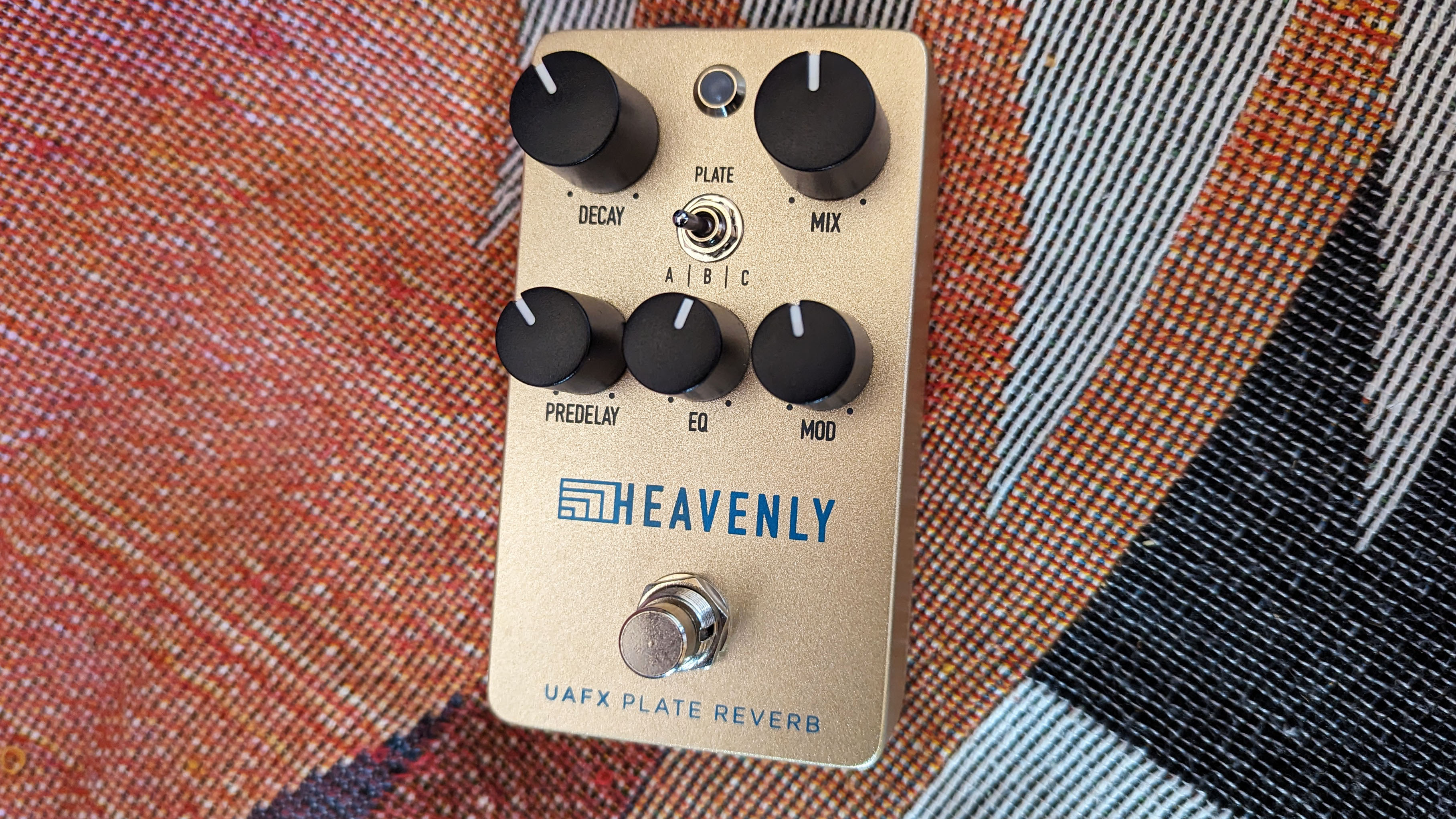MusicRadar Verdict
If you want the greatest pedal emulation of the greatest studio plate reverb hardware, this is the gold standard. But it's also found in two other UA pedals – so consider your pedalboard needs and budget.
Pros
- +
The best EMT 140 plate reverb emulations in a pedal
- +
Predelay and EQ offer deeper customisable control
- +
Switchable modulation rate is a nice bonus
Cons
- -
Mono output compared to the Starlight and Del-Verb's stereo
- -
UA's Plate 224 emulation would have been a welcome mode here
MusicRadar's got your back
Universal Audio UAFX Heavenly Plate Reverb pedal: What is it?
We've already had a spoiler with the Heavenly Plate Reverb, well two actually. We've heard it in two other previous UAFX pedals; the Golden Reverberator and the Del-Verb. We know they offer the best reverb pedal emulations of the late '50s EMT 140 plate tube reverb around, starting with its original plugin in 2007, but it's these previous pedals' presence that is impossible to separate from the existence of this more compact unit from Universal Audio, just like the Evermore Studio Reverb pedal I reviewed. We need to look at this pedal as a standalone proposition and in context with the value offered by the other pedals these same algorithms are offered in.
But first, let's take a moment to celebrate what we have here; a huge piece of studio hardware worth thousands of dollars being accurately emulated in a compact pedal for a couple of hundred.
The 1957 EMT 140 from Germany was actually the first artificial unit that didn't rely on the physical space of echo chambers to achieve its reverb. It opened possibilities to more studios, provided they could afford it. It's a system that uses an electromechanical transducer to create vibrations in a large plate of sheet metal (hence the name) and the vibrations made across this metal plate are then picked up by a pickup and outputted as an audio signal.
While the early EMT units had one pickup to deliver mono output, the EMT 140 ST had two for stereo output. At around 8 1/2 feet by over 4 feet, it certainly wasn't compact but is still regarded as the pinnacle of plate reverb. Quite a lot to shrink down to a little pedal, eh!
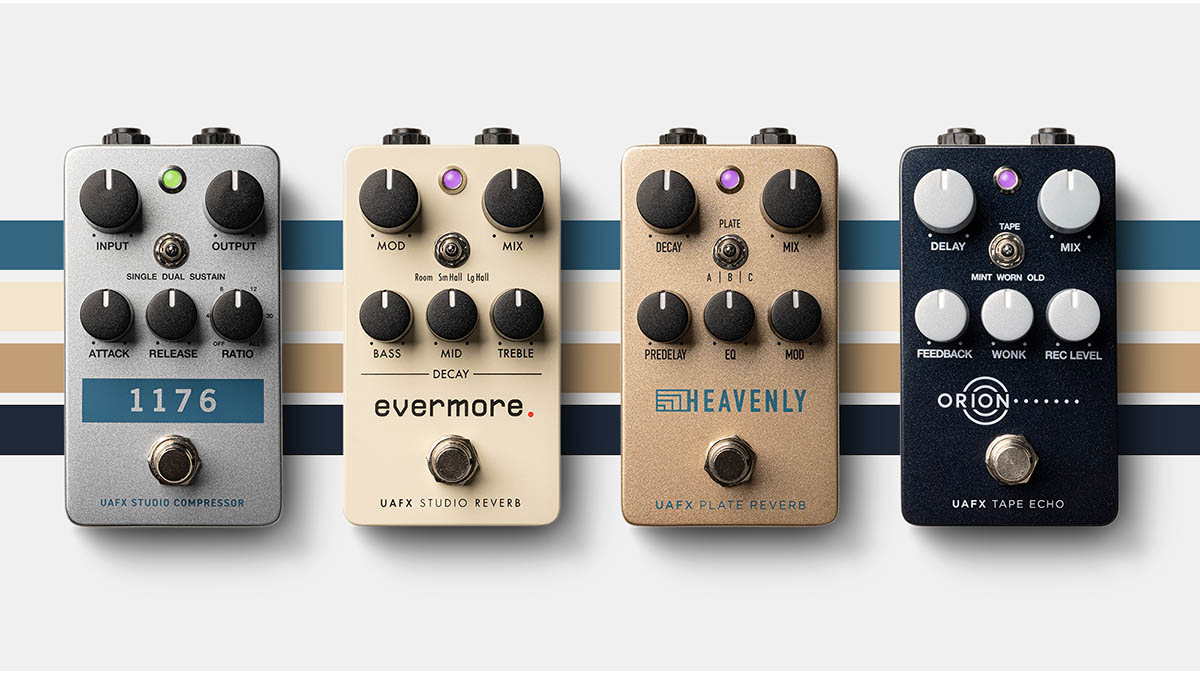
Universal Audio UAFX Heavenly Plate Reverb pedal: Performance and verdict
Let's start with the bad news: this pedal doesn't offer stereo options, something I lamented with the Evermore but applies to all the UAFX compact pedals so far. Not the larger ones. A dealbreaker for some, certainly, but UA has two of those bigger, more expensive pedals I've already mentioned to deliver the same plate reverb emulations. For the rest of you, read on…
So no stereo here, and the metallic gold at least gives the pretty basic aesthetic design here a touch of bling. It still feels a bit of a comedown compared to the larger pedals though – a little too OEM-feeling for my liking. But those gripes over, we can move on to the good stuff.
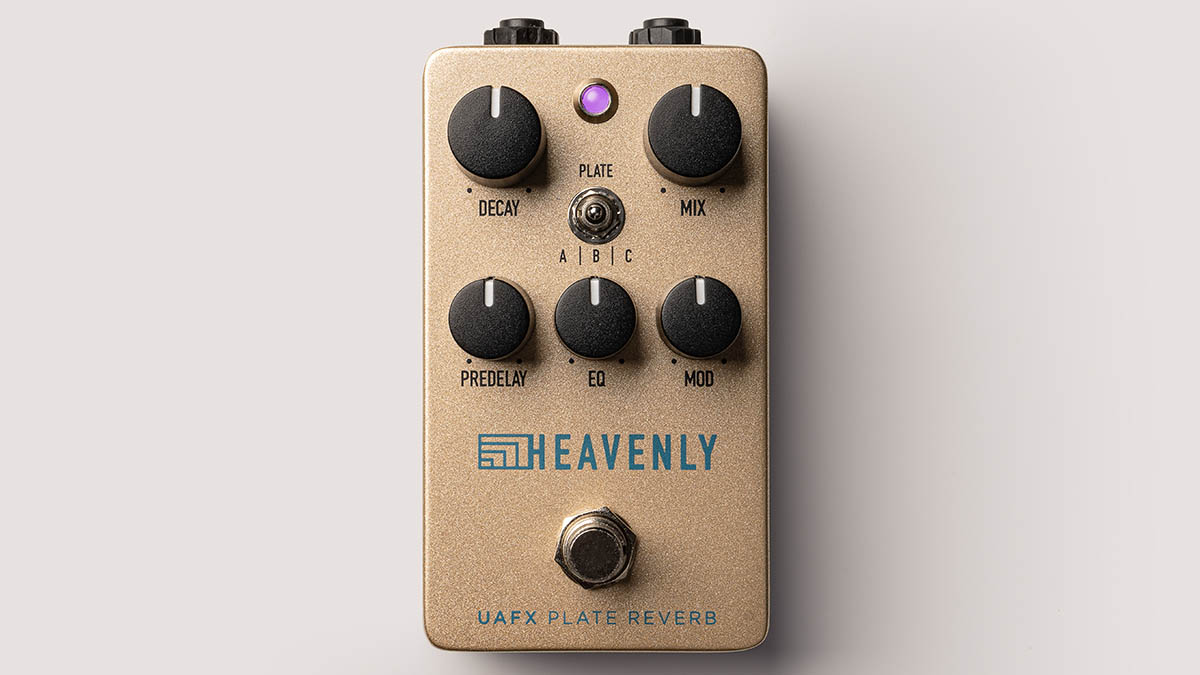
And it's very good stuff. For me, plate reverb is the most natural-sounding kind there is, and great for always-on duties. The Heavenly ticks all the boxes of a great plate reverb pedal; it's an astonishingly good emulation of the real thing, because UA excels at this stuff. Predelay, EQ, modulation – with a switch on the top of the pedal to choose between fast and slow rate – offers the reverb controls that the Del-Verb doesn't, but the Golden Reverberator mostly does. I say mostly because the ability to select between two different modulation rates is different here – on the GR there was only the Mod control for the depth and speed together.
Want all the hottest music and gear news, reviews, deals, features and more, direct to your inbox? Sign up here.
Everything you want in terms of control is here, but the differences between the three different Plate 140 algorithms is more subtle than the modes offered on the other compact compact UAFX pedals we've tested (the 1176, Evermore and Orion). They're all different effects but while it's easy to say they're not comparable, the initial instinct is to suggest this pedal offers less versatility as a standalone experience.
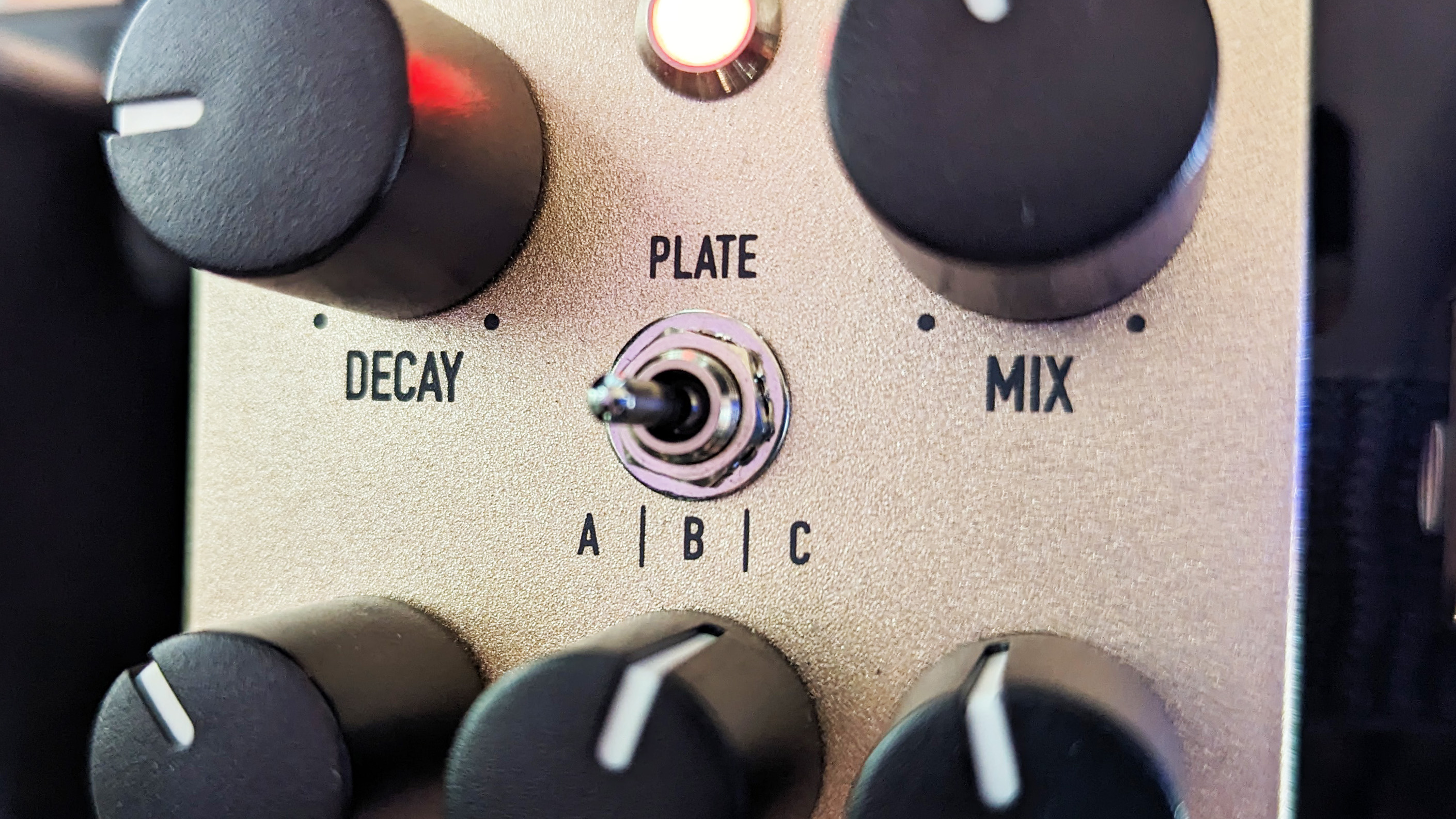
Plate A is based on an older type: bright, softer response and a shorter decay. Plat B is an older plate emulation too, but darker and a slightly longer decay. Plate C is the sound of a newer plate with a more even response, longer decay and 'natural warble' in this decay.
The audience won't notice the difference, but they're not paying for this. In isolation, you certainly will but some of the differences can be accounted for with Decay and EQ changes to some extent. Plate C definitely shines brightest in a mix to my ears, though I preferred the softer element of Plate A. However, when it comes to versatility I do feel one of these could have been substituted out for the Lexicon 224 digital plate reverb that was a bonus mode for the Golden Reverberator. That way you'd have a truly distinct mode and the Heavenly would still live up to the plate reverb billing.
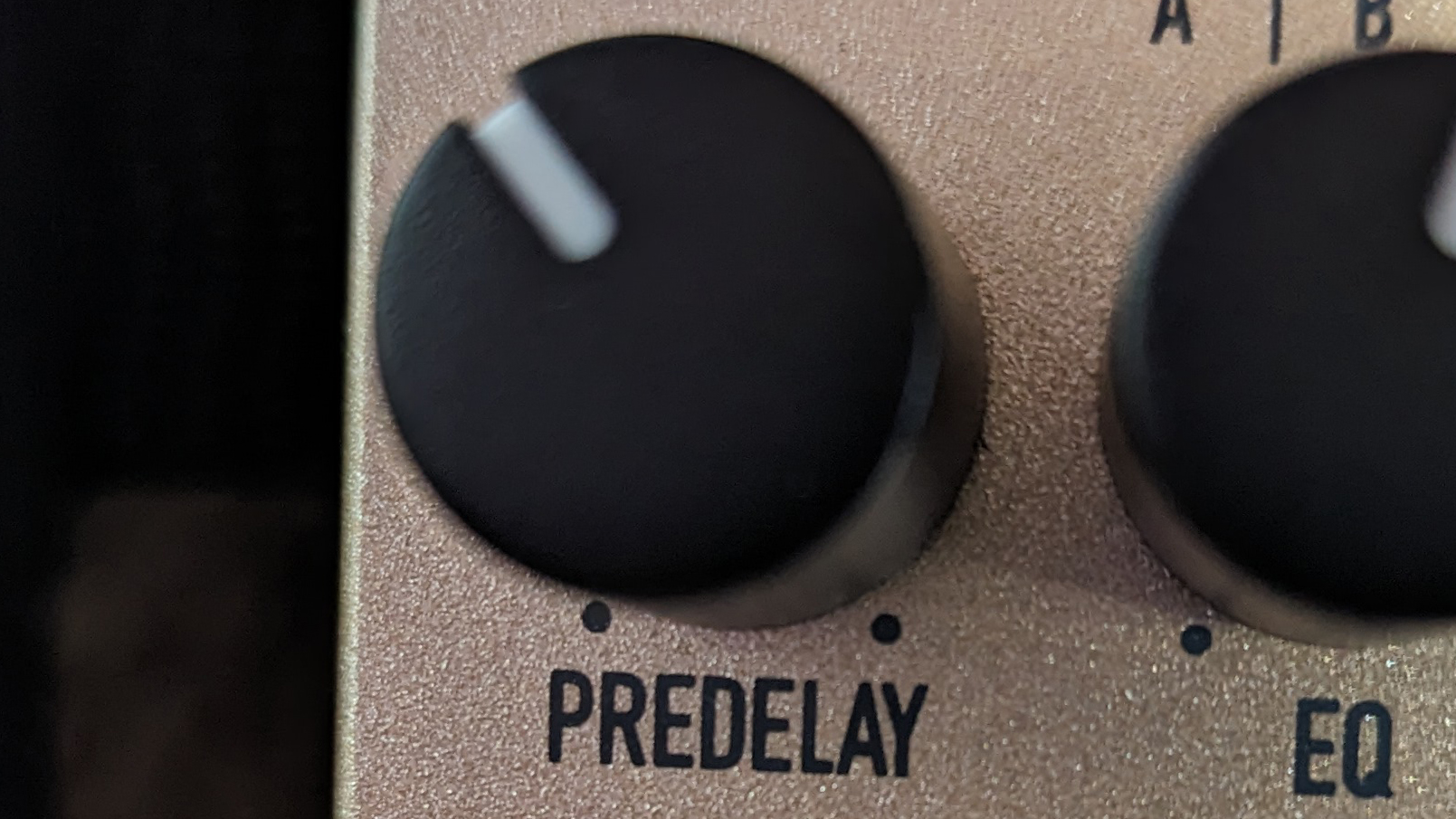
The Predelay control we missed on the Del-Verb is very much a vital inclusion here as it's central to dialling in the relationship between the dynamic of your playing and the reverb. But the same caveat we've applied to the other compact UAFX pedal remains; you may want these sounds, but more still. UA can help with that. If editability is less important to you, the Del-Verb offers one selectable plate preset from the UAFX Control App to load onto a pedal that can also host very, very good tube amp spring tank 'verb and Lexicon-emulated Hall alongside three types of delay.

For this specific plate model emulation with this level of control over it, UA is the pedal destination
If you want the control but the other types of classic reverb emulations, the Golden Reverberator is unbeatable. Both are more expensive than this, but their features justify the difference and three times as many reverb models don't equate to three times the cost – not even double. The choices are clearly by design to let players weigh up their needs, and now the new Ox Stomp offers plate reverb onboard too with its speaker emulation. That's before we even get to the versatility and value offered by the competition including Strymon, Walrus and Catalinbread. But for this specific plate model emulation with this level of control over it, UA is the pedal destination.
Apart from the minor downsides mentioned earlier and the plate mode versatility potential that I feel this slightly missed, the sounds here are beyond reproach. And that's become pretty much a given with the company and its pedals now.
MusicRadar verdict: If you want the greatest pedal emulation of the greatest studio plate reverb hardware, this is the gold standard. But it's also found in two other UA pedals – so consider your pedalboard needs and budget.
Universal Audio UAFX Heavenly Plate Reverb pedal: Hands-on demos
Sweetwater
Reverb
Mark Johnston
Andertons
Universal Audio UAFX Heavenly Plate Reverb pedal: Specifications

- TYPE: Pedal emulation of EMT 140 Plate Reverb
- CONTROLS: Decay, Mix, Plate type A/B/C mini toggle switch, Predelay, EQ, Mod, bypass footswitch, Trails/ True Bypass switch, Fast/Slow Mod Rate switch
- POWER: 9V DC pedalboard isolated power supply (250mA power draw)
- CONTACT: Universal Audio

Rob is the Reviews Editor for GuitarWorld.com and MusicRadar guitars, so spends most of his waking hours (and beyond) thinking about and trying the latest gear while making sure our reviews team is giving you thorough and honest tests of it. He's worked for guitar mags and sites as a writer and editor for nearly 20 years but still winces at the thought of restringing anything with a Floyd Rose.
